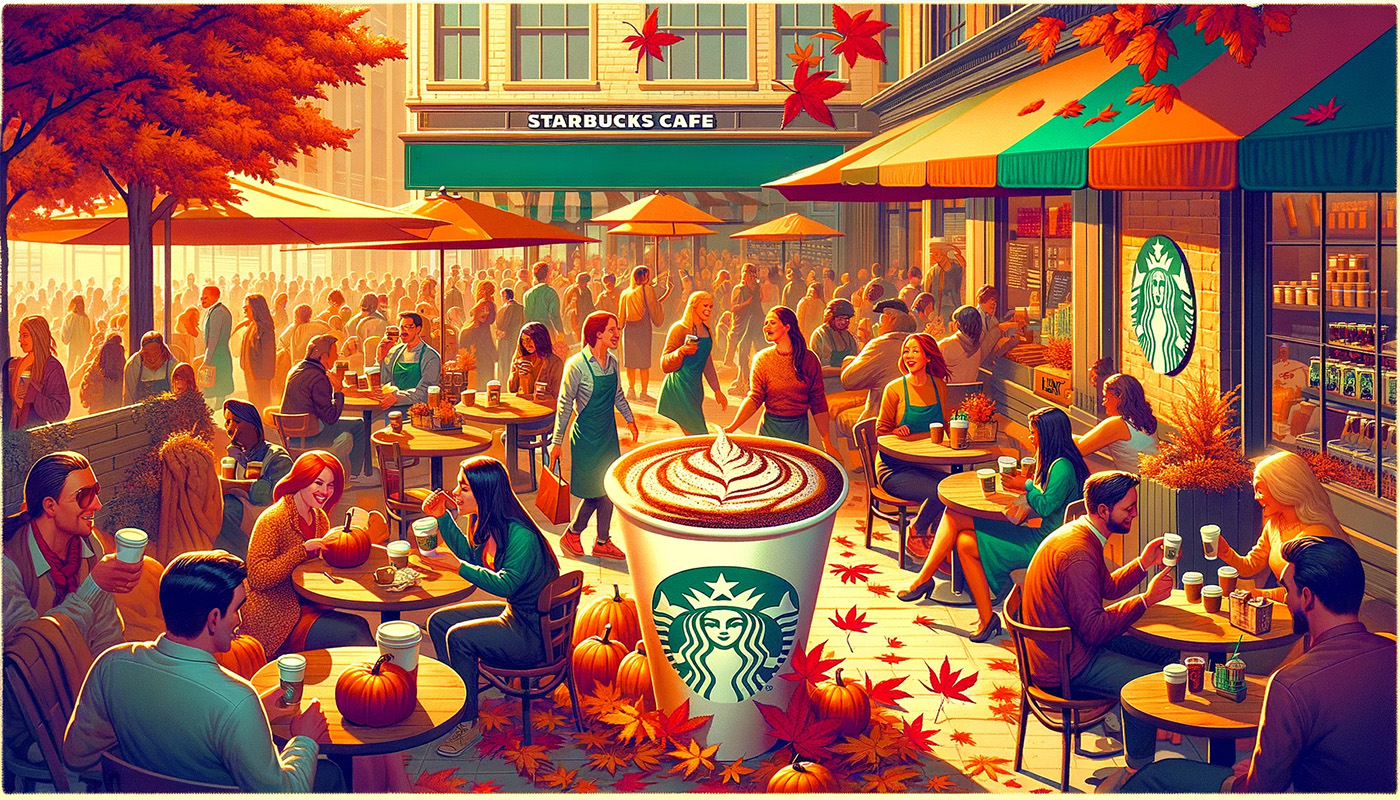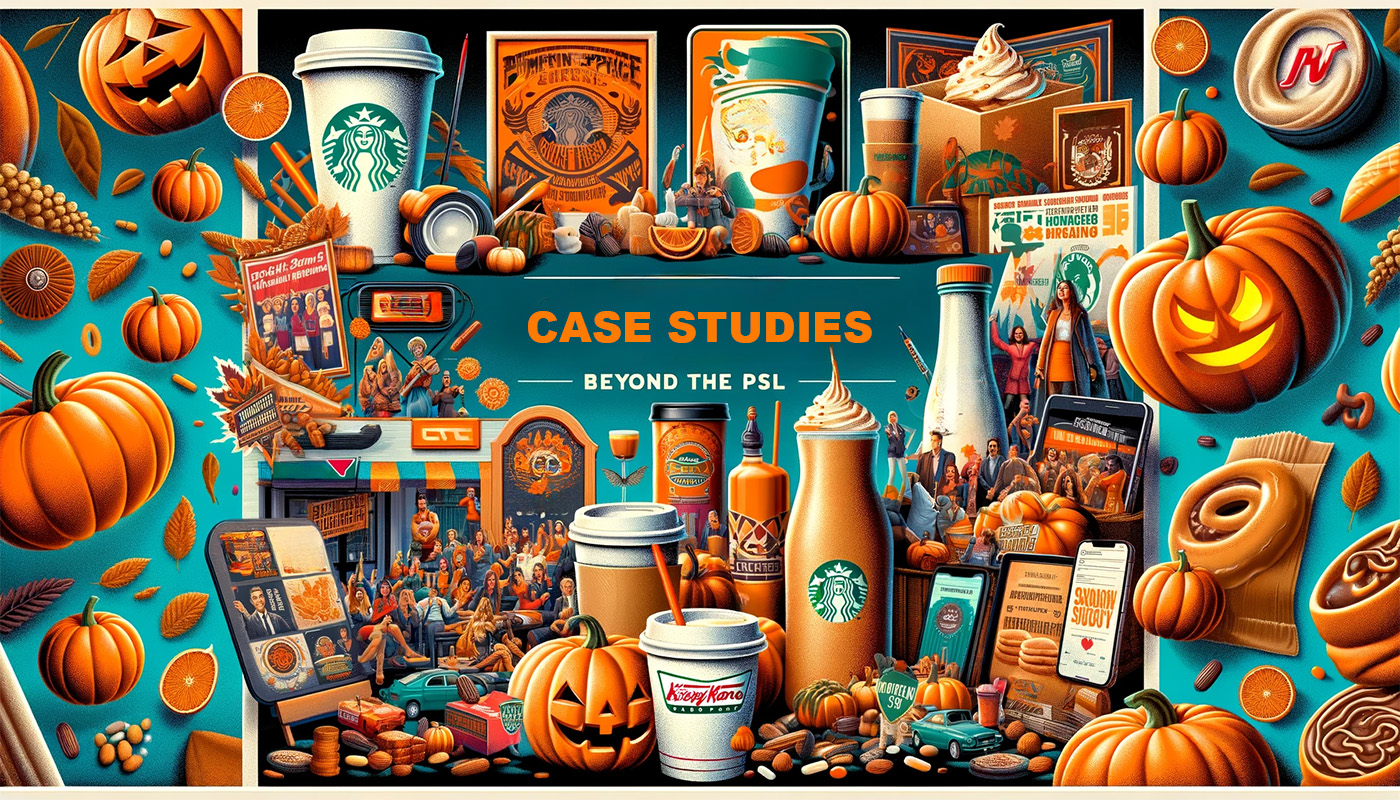When we think of fall, certain images irresistibly come to mind: falling leaves, cozy sweaters, and, thanks to a certain coffee giant, the iconic Pumpkin Spice Latte (PSL).
Celebrating its 20th anniversary, Starbucks’ PSL isn’t just a drink; it’s a cultural beacon that has captivated American taste buds and dominated social media feeds every fall season. This beloved seasonal beverage has not only warmed countless hands but also significantly boosted Starbucks’ sales, contributing to record-breaking weekly revenues.
But what makes the PSL more than just a seasonal drink? It’s the genius of pumpkin spice marketing—a blend of strategy, timing, and a deep understanding of consumer desires. In this post, we’ll explore the spice-laden path that led to the PSL becoming an American cultural phenomenon and how savvy marketers and business owners can brew their own version of this success.

The Pumpkin Spice Phenomenon
In the pantheon of seasonal beverages, few can claim the cult status of Starbucks’ Pumpkin Spice Latte (PSL). Launched in 2003, this espresso-based concoction quickly transcended its humble menu item status, becoming a symbol of fall and a marketing juggernaut.
Starbucks and the Rise of PSL
The PSL’s influence extends far beyond the confines of Starbucks, contributing significantly to the company’s sales, with over 200 million units sold in just a decade. Its success has been so impactful that it has become synonymous with Starbucks itself, reinforcing the company’s image as a leader and innovator in the coffee industry.
The Psychology Behind the Craze
The PSL’s meteoric rise can be attributed to more than just its taste; it’s deeply intertwined with the emotional connections people have with the fall season. The beverage evokes nostalgia and warmth, reminding consumers of cherished traditions like enjoying a slice of pumpkin pie on a cozy evening.
Its appeal is further magnified by its strong presence on social media platforms, particularly among millennials and Gen Z, who have embraced the PSL as a photogenic and share-worthy autumn staple. The drink’s limited availability, offered exclusively during the fall, creates a sense of urgency and anticipation, further fueling its popularity.
Economic Impact
The introduction of the Pumpkin Spice Latte has consistently resulted in a noticeable boost in Starbucks’ revenue during the fall season. This phenomenon has not gone unnoticed by the market; the PSL’s success has inspired numerous other companies, including Dunkin’ and Krispy Kreme, to introduce their own variations of pumpkin spice products.
As a result, a lucrative market segment centered around pumpkin-flavored offerings has emerged, demonstrating the far-reaching economic implications of Starbucks’ seasonal strategy.

Key Ingredients for a Marketing Craze
Crafting a marketing phenomenon like the Pumpkin Spice Latte involves more than just a great product; it requires a strategic blend of key elements. Let’s break down the essential ingredients that can help create a marketing craze.
- Forced Scarcity
- Limited Time Offers: Create a sense of urgency by offering products for a limited period.
- Exclusive Releases: Launch special editions or exclusive items to pique interest and desire.
- FOMO (Fear of Missing Out)
- Social Proof: Utilize customer testimonials, influencer endorsements, and user-generated content to show the popularity of your product.
- Viral Marketing: Design campaigns that are shareable and engaging, encouraging customers to spread the word.
- Seasonality
- Timely Connection: Align your product with a particular season or event to make it more relevant and appealing.
- Thematic Campaigns: Use seasonal themes in your marketing materials to create a cohesive and immersive experience for your audience.
By carefully mixing these ingredients, you can create a marketing strategy that not only captures the attention of your target audience but also fosters a lasting connection with your brand. Remember, the goal is to create an experience that resonates so deeply with consumers that it becomes a part of their seasonal traditions.

Creating Your Own Seasonal Sensation
In the wake of the Pumpkin Spice Latte’s success, it’s clear that a well-crafted seasonal product can be a game-changer for any brand. Here’s how you can create your own seasonal sensation:
Identifying Your ‘Pumpkin Spice’
The first step is to pinpoint what your ‘Pumpkin Spice’ is. This means understanding your brand’s strengths and how they can align with seasonal trends. It’s not just about emulating the PSL but finding a unique angle or product that resonates with your brand identity and audience.
Market Research
Deep dive into your target audience’s preferences and behaviors. What do they look forward to during the season? How can your product fit into their seasonal rituals? Market research is crucial in understanding these dynamics and crafting a product that truly connects with your audience.
Developing a Marketing Strategy
Once you have your seasonal product, it’s time to plan how to introduce it to the world. Tailor your marketing campaigns to resonate with your target demographic, be it millennials, Gen Z, or another group. Your strategy should include a mix of traditional and digital marketing, with a strong emphasis on social media to leverage the power of sharing and community engagement.
Leveraging Social Media
Social media can be a powerful tool in creating a buzz around your seasonal product. Use engaging content, collaborate with influencers, and create shareable hashtags to amplify your reach. Encouraging user-generated content can also create authenticity and a sense of community around your product.

Case Studies: Beyond the PSL
The success of Starbucks’ Pumpkin Spice Latte has inspired numerous brands to create their own seasonal sensations. Let’s explore a few case studies that showcase how different companies have successfully captured the essence of seasonal marketing.
Dunkin’s Seasonal Strategy
Dunkin’ has consistently innovated with its seasonal menu, introducing items like the Apple Cider Donut and the Peppermint Mocha Latte. Their approach focuses on combining traditional flavors with new twists, appealing to both nostalgia and curiosity. Dunkin’ leverages its social media presence to create a buzz around these seasonal offerings, often resulting in increased foot traffic and sales during key seasons.
Krispy Kreme’s Limited-Edition Flavors
Krispy Kreme is known for its limited-edition donuts, which often become the talk of the town. Their strategy involves introducing unique flavors that align with seasonal events or holidays. For example, their Halloween-themed donuts create excitement and encourage customers to visit their stores for these exclusive treats. This approach not only drives sales but also enhances brand engagement and loyalty.
Leveraging Local Festivities
Some brands have found success by aligning their products with local festivals or seasonal events. For instance, a regional cider company might release a special batch during the fall harvest festival, tapping into the local culture and traditions. This strategy creates a sense of community and belonging among the customers, strengthening their connection with the brand.

Tips and Tricks for Seasonal Success
Creating a successful seasonal marketing campaign requires more than just a great product or service; it requires strategic planning and execution. Here are some tips and tricks to help you maximize your seasonal marketing efforts:
Leverage Cultural Trends
- Understand the Season: Dive into what the season means to your target audience. For fall, themes might include cozy evenings, falling leaves, or Halloween.
- Align with Events: Tie your marketing efforts to seasonal events or holidays to increase relevance and engagement.
Create a Buzz with Limited Editions
- Limited Time Offers: Introduce products or services available for a limited period to create urgency.
- Exclusive Products: Launch special or exclusive items to generate excitement and draw attention to your brand.
Engage with Your Community
- Social Media Interaction: Use platforms like Instagram and Twitter to interact with your audience, build anticipation, and gather feedback.
- Create Shareable Content: Develop content that encourages sharing and participation, such as contests or hashtag campaigns.
Plan Ahead
- Start Early: Begin planning your seasonal marketing strategy well in advance to ensure a well-thought-out and executed campaign.
- Monitor Trends: Stay ahead of the curve by keeping an eye on emerging trends and adjusting your strategy accordingly.
Evaluate and Adapt
- Track Performance: Use analytics tools to monitor the performance of your campaigns and understand what works and what doesn’t.
- Be Flexible: Be ready to adapt your strategy based on consumer response and market dynamics.
By following these tips, you can create a seasonal marketing campaign that not only resonates with your audience but also drives sales and enhances your brand’s reputation.
Take Your Seasonal Marketing to Viral Status
Are you ready to take your seasonal marketing to the next level? Open a direct response merchant account with DirectPayNet today and ensure that your payment processing is as smooth and efficient as your marketing campaigns.
With DirectPayNet, you’ll have the support and infrastructure to handle any volume of sales, helping you make the most of your seasonal marketing success.









